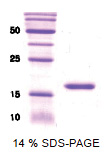CD158e / KIR3DL1 (361-444, His-tag) Human Protein
Other products for "KIR3DL1"
Specifications
| Product Data | |
| Species | Human |
| Expression Host | E. coli |
| Expression cDNA Clone or AA Sequence |
MRGSHHHHHH GMASMTGGQQ MGRDLYDDDD KDRWGSTSGT IDKLDIEFHL WCSNKKNAAV MDQEPAGNRT ANSEDSDEQD PEEVTYAQLD HCVFTQRKIT RPSQRPKTPP TDTILYTELP NAKPRSKVVS CP
|
| Tag | His-tag |
| Predicted MW | 15 kDa |
| Concentration | lot specific |
| Purity | >95% by SDS-PAGE |
| Presentation | Purified |
| Buffer | Presentation State: Purified |
| Protein Description | This protein was purified by FPLC gel-filtration chromatography, after refolding of the isolated inclusion bodies in a redox buffer. |
| Storage | Store at 2 - 8 °C for up to one month or (in aliquots) at -20 °C. Avoid repeated freezing and thawing. |
| Stability | Shelf life: one year from despatch. |
| Reference Data | |
| RefSeq | NP_001309097 |
| Locus ID | 3811 |
| UniProt ID | P43629, Q6H2G3, Q8N6C9 |
| Cytogenetics | 19q13.42 |
| Synonyms | CD158E1; KIR; KIR2DL5B; KIR3DL1/S1; NKAT-3; NKAT3; NKB1; NKB1B |
| Summary | Killer cell immunoglobulin-like receptors (KIRs) are transmembrane glycoproteins expressed by natural killer cells and subsets of T cells. The KIR genes are polymorphic and highly homologous and they are found in a cluster on chromosome 19q13.4 within the 1 Mb leukocyte receptor complex (LRC). The gene content of the KIR gene cluster varies among haplotypes, although several "framework" genes are found in all haplotypes (KIR3DL3, KIR3DP1, KIR3DL4, KIR3DL2). The KIR proteins are classified by the number of extracellular immunoglobulin domains (2D or 3D) and by whether they have a long (L) or short (S) cytoplasmic domain. KIR proteins with the long cytoplasmic domain transduce inhibitory signals upon ligand binding via an immune tyrosine-based inhibitory motif (ITIM), while KIR proteins with the short cytoplasmic domain lack the ITIM motif and instead associate with the TYRO protein tyrosine kinase binding protein to transduce activating signals. The ligands for several KIR proteins are subsets of HLA class I molecules; thus, KIR proteins are thought to play an important role in regulation of the immune response. [provided by RefSeq, Jul 2008] |
| Protein Families | Transmembrane |
| Protein Pathways | Antigen processing and presentation, Graft-versus-host disease, Natural killer cell mediated cytotoxicity |
Documents
| FAQs |
| SDS |
Resources
Recombinant Protein Resources |
{0} Product Review(s)
0 Product Review(s)
Submit review
Be the first one to submit a review
Product Citations
*Delivery time may vary from web posted schedule. Occasional delays may occur due to unforeseen
complexities in the preparation of your product. International customers may expect an additional 1-2 weeks
in shipping.






























































































































































































































































 Germany
Germany
 Japan
Japan
 United Kingdom
United Kingdom
 China
China
